This is the third and final part of my series which explores implementing GraphQL using Apollo and NextJS.
Part 1 dealt with the app setup, and Part 2 dealt with the Client-Side in depth. I would highly recommend reading them first before getting into this article, unless you are already comfortable with Client-Side GraphQL using Apollo.
If you are completely new to GraphQL, please read my beginners tutorial here.
This article discusses the Server-Side implementation of Apollo. Let’s being!
A quick refresher/reminder: We leverage NextJS’ internal API Routes system to accept a GraphQL query, and by using apollo-server-micro (not apollo-server!), we are able to return GraphQL compliant results.
This is the Server-Side code for the app, and you can find it in the full project here.
import { ApolloServer, gql } from "apollo-server-micro";
let book = {
name: "The Hungarian Sausage",
author: "Ben Grunfeld",
};
const typeDefs = gql`
type Book {
name: String
author: String
}
type Query {
book: Book
}
type Mutation {
updateBook(name: String!, author: String!): Book
}
`;
const resolvers = {
Query: {
book: () => book,
},
Mutation: {
updateBook: (root, args) => {
book.name = args.name;
book.author = args.author;
return book;
},
},
};
const server = new ApolloServer({ typeDefs, resolvers });
const handler = server.createHandler({ path: "/api/graphql-data" });
export const config = {
api: {
bodyParser: false,
},
};
export default handler;
#graphql #apollo-server #apollo #nextjs
